Are you a Quiet Speculation member?
If not, now is a perfect time to join up! Our powerful tools, breaking-news analysis, and exclusive Discord channel will make sure you stay up to date and ahead of the curve.
The saying goes that those who fail to learn from history are doomed to repeat it. In Modern, those who do not observe the metagame are doomed to be passed by. Applied to Magic, such proverbs encourage every player to duly note how the metagame evolves and develops over a competitive year. Having spent the year tracking those twists and turns, it's now time to recap and learn from them.
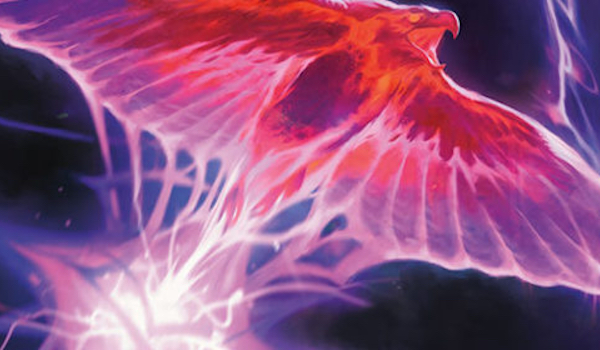
Just like last year, today I'll be looking back on 2019's metagame. Part of the process involves charting the ups and downs of a wild year in Modern. Another part consists of identifying trends that may influence the 2020 metagame. The future is impossible to predict, but can be guessed at given current trends; today, we'll search for those that appear to persist despite the metagame's churn.
From the Scrapheap
 2019 kicked off with the metagame being disrupted by an unexpected banning. Krark-Clan Ironworks had tremendous success in the hands of Matt Nass early in 2018, and Wizards was concerned about its non-interactivity and resilience eventually taking over Modern. The deck had started showing up in quantity at events despite a relative drought, and was beating hate despite its weaknesses being known. There was also the problem of Ironworks being really boring to watch. Therefore, they decided to preemptively nuke Ironworks, the presumptive best deck; the metagame then largely reverted to its 2018 state.
2019 kicked off with the metagame being disrupted by an unexpected banning. Krark-Clan Ironworks had tremendous success in the hands of Matt Nass early in 2018, and Wizards was concerned about its non-interactivity and resilience eventually taking over Modern. The deck had started showing up in quantity at events despite a relative drought, and was beating hate despite its weaknesses being known. There was also the problem of Ironworks being really boring to watch. Therefore, they decided to preemptively nuke Ironworks, the presumptive best deck; the metagame then largely reverted to its 2018 state.
Firebird's Ascent
With Ironworks gone, the metagame began to coalesce around Arclight Phoenix. Izzet Phoenix's high velocity let it play a very consistent gameplan while Manamorphose and Faithless Looting allowed it to blitz any deck that couldn't disrupt its engine. Thing in the Ice proved to be a house against creature decks and a surprisingly robust threat in its own rite. Phoenix took over as Modern's most successful deck judging by Top 8s and Day 2 presence during March 2019.
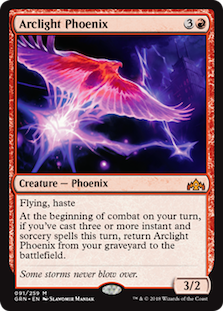 However, in April, the tide began to turn. Players had caught on that the key to fighting Phoenix wasn't actually going after Phoenix itself, but the cantrips that fueled the engine. By the end of the month, Humans had situated itself as a clear challenger to Phoenix. Of the options, Humans made the most sense in that role, since Thalia, Guardian of Thraben, the natural enemy of velocity, was an integral piece of the deck. Reflector Mage is also very strong in a matchup where opponents rely on the bounce-able Thing in the Ice as board interaction. At the start of May, it looked like Phoenix's reign was coming to an end, as predation had kicked in and the metagame was adapting.
However, in April, the tide began to turn. Players had caught on that the key to fighting Phoenix wasn't actually going after Phoenix itself, but the cantrips that fueled the engine. By the end of the month, Humans had situated itself as a clear challenger to Phoenix. Of the options, Humans made the most sense in that role, since Thalia, Guardian of Thraben, the natural enemy of velocity, was an integral piece of the deck. Reflector Mage is also very strong in a matchup where opponents rely on the bounce-able Thing in the Ice as board interaction. At the start of May, it looked like Phoenix's reign was coming to an end, as predation had kicked in and the metagame was adapting.
Outside Phoenix, the metagame looked rather unremarkable. The usual players from 2018 continued to put up numbers and see success, none more than Dredge. Ironically for a graveyard deck, Dredge was able to piggyback off Phoenix's success thanks to Phoenix diluting anti-grave sideboard cards. Dredge is very resilient to one-shot hate, but struggles against persistent hate. The only reason to attack Phoenix's graveyard is Phoenix itself, and so players relied on Surgical Extraction, to my consternation. Dredge was able to sneak through the cracks and continue to find success until the end of the month.
The Great Churn
Beginning in May, the middle of the year saw what I'm going to call the Great Churn. Three sets were released in three months, which is an absurd influx of cards. This was exacerbated by one being Modern Horizons, a set with exceptionally high power compared to Standard-ready expansions. Naturally, this threw Modern's metagame into a chaotic state of flux all summer. Even when it appeared to have stabilized, there would be constant churn beneath the surface. In many ways, this churn is ongoing; many promising cards that failed to gain traction during the summer are gradually being rediscovered. Meanwhile, the churn has been added to thanks to Throne of Eldraine.
War of the Spark
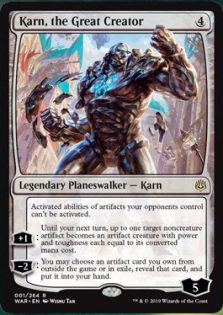 May opened with the release of War of the Spark, and Magic was flooded with cheap planeswalkers. While Narset, Parter of Veils and Teferi, Time Raveler gave control players dreams of Modern dominance, the reality was that Karn, the Great Creator has been the standout planeswalker from War.While initially just seen as a Tron card (being colorless), Karn has found homes in every artifact deck imaginable.
May opened with the release of War of the Spark, and Magic was flooded with cheap planeswalkers. While Narset, Parter of Veils and Teferi, Time Raveler gave control players dreams of Modern dominance, the reality was that Karn, the Great Creator has been the standout planeswalker from War.While initially just seen as a Tron card (being colorless), Karn has found homes in every artifact deck imaginable.
The initial excitement centered on Karn locking out opponents by wishing for Mycosynth Lattice, which gave the plodding ramp deck its first I Win button since Emrakul, the Aeons Torn. However, it has since become clear that Lattice is the most optimistic target, and the real value is that repeatable wishes are very good. This has allowed Karn to remain a relevant force in the metagame as it continues shifting and the Lattice lock becomes less needed. There were few events during this period, so players were still experimenting when Wizards dropped a bomb on Modern.
Modern Horizons
The much anticipated Modern Horizons released in June. How Hogaak, Arisen Necropolis slipped through Wizards' net I cannot understand, but it was bad news from the get-go. Modern was already flush with graveyard enablers, and Hogaak proved to be the ultimate payoff. It took the dangerously explosive but inconsistent BridgeVine deck and supercharged it, combining with Altar of Dementia to infinitely mill out first itself, then the opponent. The deck was so ridiculous that it shunted aside all the other interesting cards in Horizons, and after less than a month, Wizards decided to nerf Hogaakvine ahead of the next set release and a string of Modern GPs.
Core 2020
For a short period, it looked like the nerf worked. July saw Core 2020 released, and during the early weeks, Hogaak was a non-issue in the metagame. Core 2020 contained plenty of interesting cards, including one now banned in multiple formats, but its low power compared to Horizons has rendered Core relatively unimpressive for Modern. The cooldown gave 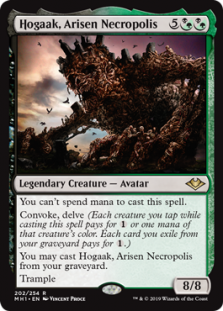 Modern the opportunity to finally try to understand just what had happened with Horizons. However, this grace period was not to last. It turned out that Hogaak had merely been metamorphosing. Like a caterpillar turning into a butterfly, Hogaak was about to find its final form.
Modern the opportunity to finally try to understand just what had happened with Horizons. However, this grace period was not to last. It turned out that Hogaak had merely been metamorphosing. Like a caterpillar turning into a butterfly, Hogaak was about to find its final form.
August was Modern season on the competitive circuit, and it was dominated by this new wave of Hogaak decks. July ended with Hogaak dominating at the Mythic Championship weekend and the concurrent SCG open. Hogaak then continued to crush events despite every deck piling on the graveyard hate. The deck was too powerful, too consistent, and too hard to fight for any other deck to reliably beat. In the end, Wizards was forced to kill Hogaak for good. However, they also went a step further. Graveyard decks had defined Modern for years, and despite a previous banning, Dredge was still a force in Modern. The time had come to end an era, and to keep the graveyard decks down, Faithless Looting was axed too.
A Whole New World
The best graveyard enabler was gone, the obviously-broken deck was dead, and the format 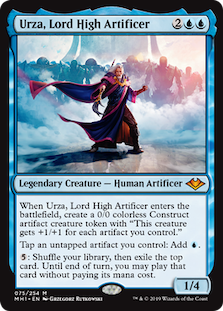 still didn't know what to do with all the cards that had flooded in. However, despite some continuing Dredge presence, Phoenix had died and nothing similar has emerged. September was spent brewing and experimenting as Throne of Eldraine also brought new cards into Modern. The metagame began to take actual shape in October, as Modern returned to the competitive calendar.
still didn't know what to do with all the cards that had flooded in. However, despite some continuing Dredge presence, Phoenix had died and nothing similar has emerged. September was spent brewing and experimenting as Throne of Eldraine also brought new cards into Modern. The metagame began to take actual shape in October, as Modern returned to the competitive calendar.
It quickly became clear that Urza, Lord High Artificer was the new Next Thing, but what that thing actually is remains elusive; over the past few months, Urza decks have taken numerous forms. The deck is built around a solid core of free-to-cheap artifacts, but the payoffs have swung between combo, prison, or value. The most recent events indicate that riding the value engine of Oko, Thief of Crowns is winning the popularity contest... at least, for the time being.
Metagame Trends
It is strange to think that 2019 has ended much as it began. The year started with Ironworks, a deck built around free-to-cheap artifacts, being the apparent deck to beat. And it's ending with Simic Urza, another such deck, in that same role. The more things change, as the saying goes. However, it is critical to look deeper, as the truth is that beyond the "best deck," the metagame continues to display remarkable diversity: Tron is consistently showing up to punish the ponderous decks; Humans is beating up on the cheap-spell decks; Grixis Death's Shadow is returning to take on Urza. Modern continues to be a play-what-you-want format despite the apparent domination of certain decks.
Gravely Departing
Decks that synergize with the graveyard will always be in Modern. There are too many synergies and powerful graveyard cards for that not to be the case. However, it is probable 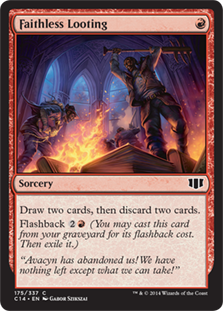 that the era of graveyard dominance is over. Faithless Looting made it extremely easy for decks to make controlled dumps into their graveyard while simultaneously improving their hands. Thus Looting turned graveyards into an extension of the hand for one mana. And could do so again thanks to flashback. Without a clear replacement, few decks will effectively utilize their graveyards effectively anymore.
that the era of graveyard dominance is over. Faithless Looting made it extremely easy for decks to make controlled dumps into their graveyard while simultaneously improving their hands. Thus Looting turned graveyards into an extension of the hand for one mana. And could do so again thanks to flashback. Without a clear replacement, few decks will effectively utilize their graveyards effectively anymore.
There are plenty of spells that dump cards en masse like Stitcher's Supplier, but they're random, and thus inconsistent. No fine tuning, just brute force. Haggle is as close as Modern is likely to get for the foreseeable future, and it is a hollow shadow of Looting. Whatever becomes of Modern moving forward, it is likely to be tangential to the graveyard, rather than utilize it intrinsically.
Laying Eggs
Similarly, the cheap artifact shell will remain relevant. The combination of Arcum's Astrolabe, Mox Opal, Mishra's Bauble, and Engineered Explosives first (mostly) wielded by Ironworks has proven itself adaptable enough to anchor multiple strategies. It's unlikely that anything from that core itself will ever be banned.
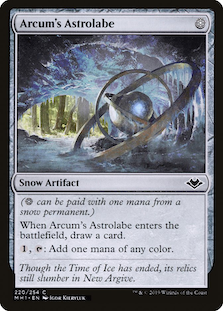 Its main draw is that it's cheap as free. Other options like Everflowing Chalice or Witching Well aren't as individually powerful as Explosives or Astrolabe, but they don't need to be. The shell's purpose is to be free more than anything, and free is a very powerful enabler. Therefore, the shell will be with Modern for some time.
Its main draw is that it's cheap as free. Other options like Everflowing Chalice or Witching Well aren't as individually powerful as Explosives or Astrolabe, but they don't need to be. The shell's purpose is to be free more than anything, and free is a very powerful enabler. Therefore, the shell will be with Modern for some time.
Which payoffs use this shell is not clear. Right now Oko, Thief of Crowns and Urza, Lord High Artificer hold the title, but they're both on my banning watchlist for good reason. Outside of Oko and Urza, the proven artifact payoff is Arcbound Ravager, but I doubt Affinity is the right home. Affinity does play a lot of free-to-cheap artifacts, but those must contribute to an aggro plan; that deck wants Memnite and Signal Pest, not Bauble and Astrolabe. The alternative shell would need to be more midrange- or combo-focused to turn the durdly artifacts into something useful. So long as Oko and Urza survive, they're better than the other options, so there's little reason to scope out alternatives. Regardless, much like this year did, 2020 will begin with an artifact deck looming over Modern.
Look to the Future
With the start of a new competitive cycle and more sets for Modern to struggle to absorb, 2020 looks to be a dynamic year. Hopefully not as extreme as 2019, though; I don't know if I'm ready for another Eldrazi Winter or Hogaak Summer. The original Theros block didn't do much for Modern, so perhaps the trend will continue when we return to Theros in January. Only time will tell.




